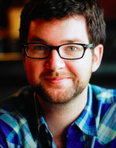
Jason Curtis, soon to be an NSF postdoctoral fellow a Columbia University
Jason Curtis’s PhD thesis is on the “old”, nearby open cluster Ruprecht 147. I first came across this cluster when naively looking for an “old” (> 1 billion years) open benchmark cluster to compare field stars with, as part of the GPI target selection group when I was a postdoc at Berkeley.
The cluster was listed in the online open cluster database WEBDA as being nearby (within 500 pc) and “old” (globular cluster astronomers would call it “intermediate aged”— 10 Gyr is old!). This was based on work by Kharchenko et al. in 2005 who used “known” stellar associations’ proper motions to find new members (fitting their brightnesses and colors with stellar isochrones) and pin down their cluster parameters in a uniform way. But they had not looked hard at Ruprecht 147 itself, and its fit seemed poor to me—the isochrone passed through the blue stragglers, for instance.

Distances and ages of clusters in WEBDA. The blue open circle is where I had found Ruprecht 147 (in the database) in 2007. The closed circle is Jason Curtis’s value. What’s that red point?
It turns out that prior to Kharchenko’s work, it wasn’t even clear than Ruprecht 147 was a real cluster. Jason’s paper beautifully traces out the history here, but basically the overdensity of stars in Sagittarius that marks the cluster was noticed over 150 years ago by John Herschel, but not really believed to be anything other than an asterism by most observers since. Jaroslav Ruprecht “rediscovered” the cluster about 50 years ago (accidentally giving it a new name), and both that entry and Herschel’s have been dutifully copied from catalog to catalog ever since.
After much work, Jason Curtis established that Kharchenko was absolutely correct that many stars in the area share a common proper motion: the cluster is real, truly nearby, and truly not young. His refined cluster parameters (300 pc and 3Gyr) are reflected in the figure above (the blue “C13” point). As you can see, Ruprecht 147 is superlatively old and nearby, much closer than M67 and much older than Praesepe, two critical benchmarks in stellar astrophysics. With over 100 members, Ruprecht 147 is poised to become a similarly important object of study (which is one thing Jason will work on as an NSF postdoctoral fellow at Columbia University in Marcel Agüeros’s group).
Ruprecht 147 had escaped notice for so long because it sits in Sagittarius—one of the densest regions of stars in the sky—and because it is so close that its stars are scattered over many square degrees. Its age also hurts it: all of its O, B, and A stars have long since evolved past the giant phase and are now gone or too faint to notice (the remaining 5 or 6 A stars are blue stragglers) so there are few bright stars to draw they eye’s attention like in Praesepe. It was the Tycho proper motions that made it stand out to the point that Kharchenko’s algorithms proved it to be real.
That figure also shows two other objects, NGC 2240 and Lodén 1, that might be similarly important, if real. What are they? Could they be new benchmarks in stellar astrophysics?
Jason Curtis and I put former Penn State undergraduate (and, later, baccalaureate researcher) Eunkyu Han on the case, and her paper is now ready for publication.
More in the next installment…
